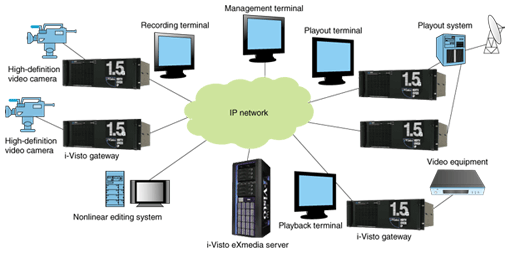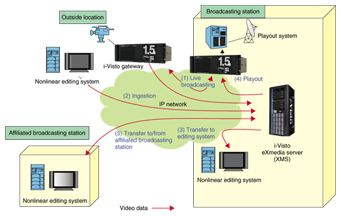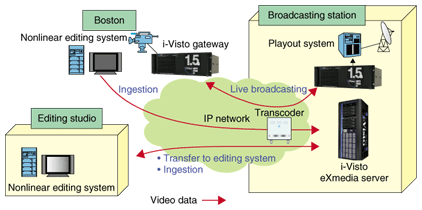 |
|||||||||||||||||
|
|
|||||||||||||||||
|
Letters Vol. 6, No. 3, pp. 62–67, Mar. 2008. https://doi.org/10.53829/ntr200803le3 Experiments in Transferring High-definition Video Material over an IP NetworkAbstractTo verify technology for transferring high-definition video material in the next-generation video system, we performed experiments using our ultrahigh-speed server system (i-Visto eXmedia server system) over an IP (Internet protocol) network in conjunction with a broadcasting company. By applying it to actual processes, we showed through these experiments that our system is useful for broadcasting processes. In this article, we outline the server system and describe the experimental method.
1. IntroductionBroadcasting companies need to produce high-definition video programs to prepare for the start of digital terrestrial broadcasting. To produce such video programs, it is important to collect high-definition video material rapidly and at a low cost; however, the transfer of video material requires a 1.5-Gbit/s network. It is too difficult to transfer the material without compression over the legacy network used for video material. The video material network, which is composed of satellite links or ATM (asynchronous transfer mode) links with insufficient bandwidth, is generally shared by two or more broadcasting stations [1]. The processing delay involved in compression and decompression makes it difficult to transfer video material at any time and to hold natural conversations between a broadcasting studio and an outside location during a program. We are developing the i-Visto eXmedia server system (XMS system), which can transfer, store, and deliver high-definition video without compression over an IP (Internet protocol) network constructed with optical fibers [2]. Recently, the bandwidth of IP networks has increased and the network cost has decreased rapidly. Moreover, an IP network can be available all the time once it has been connected. To verify that the above problem can be solved by using our system, we performed experiments in transferring video material by executing actual broadcasting processes in conjunction with a broadcasting company. In the experiments, live broadcasts and the transfer of video material from Boston (USA) to Osaka (Japan) and from Osaka to Tokyo was done for the broadcasting of programs. The results of the experiments show that the system enabled natural conversations and made it possible to broadcast video 30 minutes after the end of shooting in Boston. Section 2 introduces the XMS system, Section 3 describes three experiments, and Section 4 concludes with a summary and a brief mention of future plans. 2. i-Visto eXmedia server systemA typical configuration of the XMS system is shown in Fig. 1. The system is mainly composed of i-Visto eXmedia servers, i-Visto gateways, playback terminals, recording terminals, playout terminals, and management terminals. The i-Visto eXmedia server is an ultrahigh-speed server that can store and deliver 16 uncompressed high-definition video streams simultaneously over an IP network. It can also store and deliver compressed video streams. The i-Visto gateway can convert an HD-SDI (high-definition serial digital interface) signal to IP packets within 5 ms and send them to another i-Visto gateway or i-Visto eXmedia server. The i-Visto gateway can also reformat from received IP packets to an HD-SDI signal within 10 ms. This i-Visto gateway is an enhanced version of the i-Visto gateway XG [3]. The playback terminal can play back a video stream from the server. The recording terminal can store a video stream on the server. The playout terminal is used for sending a video stream to a playout system in the broadcasting station. The management terminal can monitor the status of this equipment, which has been developed in NTT laboratories. For nonlinear editing systems in the XMS system, we can use commercially available systems.
The XMS system is applicable to the following broadcasting processes, as shown in Fig. 2. Although these processes have been implemented using videotape, coaxial cables, and dedicated video networks, they can be shifted over to the IP network by introducing our XMS system. Moreover, using the XMS system provides the following advantages to the processes.
(1) Live broadcasting Using i-Visto gateways enables full-duplex transmission of live uncompressed high-definition video between an outside location and a broadcasting studio. Even if the location is overseas, natural conversation between the studio and the location is possible. (2) Ingestion From a remote recording studio or an outside location, using the i-Visto gateway and the recording terminal makes it possible to store (ingest) video material into the i-Visto eXmedia server through the IP network. Before the introduction of our system, videotapes and a storage area network were used to store video material. Stored video material is used for the programs' editing process and playout process. There is less delay before editing can start when one is not recording to tapes and not physically transporting the tapes. Although the storage area network is based on optical fiber, it has a distance limitation of 2 km as a result of its architecture. Therefore, it is difficult to store video material from a remote studio far from the broadcasting station. (3) Transfer to/from editing studio The video material is edited for a broadcasting program in an editing studio. A video editor in the editing studio can directly transfer video material from the i-Visto eXmedia server through the IP network. He or she can also directly transfer edited video to the server. (4) Playout Using a playout terminal and the i-Visto gateway makes it possible to send video stored in the i-Visto eXmedia server to a playout system through the IP network in the broadcasting station. The XMS system can send videos in turn with a short response time of a few milliseconds and can remotely start and stop the sending video through the IP network. (5) Transfer to/from affiliated broadcasting stations Generally, affiliated broadcasting stations use video material that is shot by a parent broadcasting station. The XMS system can retrieve video material and transfer it from a parent broadcasting station. Before the introduction of our system, a parent broadcasting station could only select video material to send to affiliated stations and send the selected material to them at particular times. However, the XMS system enables an affiliated station to play back video material with a VCR-like controller (VCR: video cassette recorder) and obtain any video material at any time through the IP network. It supports VCR-like functions of fast forward, fast rewind, pause, and frame-by-frame playback. It enables any scene to be searched for using these playback functions. As mentioned above, the XMS system supports not only live broadcasting but also almost all broadcasting processes: ingestion, transfer to/from an editing studio, playout, and transfer to/from affiliated broadcasting stations. 3. ExperimentsTo check whether or not the XMS system using the IP network is applicable to actual broadcasting processes, we performed the following three experiments from April to August 2007 in conjunction with Asahi Broadcasting Corporation located in Osaka. Experiment 1: Live broadcasting, ingestion of video material, and transfer to an editing studio The system configuration for the experiments is shown in Fig. 3. We set the i-Visto gateways in both Boston and the broadcasting station in Osaka. The IP network connected between Boston and Osaka was composed of JGN2 [4], GEMnet2 [5], Internet2 [6], and Northern Crossroads network [7].
We tested live broadcasting four times in total with no problems. Uncompressed high-definition video was transferred both ways between Boston and Osaka. The transmission delay from Boston to Osaka was less than 100 ms. Therefore, casters both in the studio and at the outside location were satisfied because they could have natural conversations. We also transferred video material from Boston to the i-Visto eXmedia server in Osaka just after it was shot with a video camera. The video was compressed by the DVCproHD encoder in the video camera and recorded to flash memory in the camera. After the video was captured in a notebook PC, we transferred it from the PC to a transcoder in order to decode the compressed video. Furthermore, we output video material from the server in the editing studio and edited it. We confirmed that we could finish video editing within 30 minutes after the start of the transfer. Experiment 2: Transfer of video material about an election to an affiliated broadcasting station The system configuration for the experiment is shown in Fig. 4. First, after linear editing of the video material, which was shot in the office for candidates, in the broadcasting station, the video material was stored in the i-Visto eXmedia server in Asahi Broadcasting Corporation by using a recording terminal and the i-Visto gateway. Second, we retrieved video material, searched for necessary scenes, and played them back using a playback terminal at TV Asahi Corporation in Tokyo. Although the distance between Osaka and Tokyo is 600 km, we were able to play back the material with the same operability as the VCR beside the playback terminal. We also confirmed that the XMS system enabled the receiver to select any video and any scene, whereas before the introduction of our system, material could be selected only by the sending broadcasting station.
Experiment 3: Transfer video material about a baseball tournament to an affiliated broadcasting station We used the system shown in Fig. 4 in the experiment. This time, we used a nonlinear editing system instead of a linear one. The video material was compressed by a DVCproHD encoder and the edited video was transferred directly from the editing system to the transcoder. The video was decoded by the transcoder and transferred to the i-Visto eXmedia server in Osaka and stored in it. Thus, we were able to play back any scene of any video in Tokyo in the same way as in the previous experiment. Since we did not use any tapes in the experiment, we could play back the video 30 seconds after editing finished. We confirmed that the XMS system is suitable for a news broadcasting system. We also confirmed the reliability of the XMS system because it never stopped during these experiments. 4. ConclusionTo verify that the XMS system that we have developed is applicable to broadcasting processes, we performed experiments in which we applied it to actual broadcasting processes in conjunction with a broadcasting company. As a result, we found that the XMS system with an IP network is applicable and can improve the broadcasting process, especially live broadcasting and transfer between affiliated broadcasting stations. In the future, we will improve the user interface and make the XMS system more reliable. AcknowledgmentsWe thank Keishi Kandori of Asahi Broadcasting Corp. for allowing us to perform these experiments, Leo D. Donnelly of Harvard University for supporting the IP network configuration in the USA, and Hiroshi Suzuki of TV Asahi Corporation for testing our server system. References
|
|||||||||||||||||














